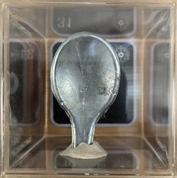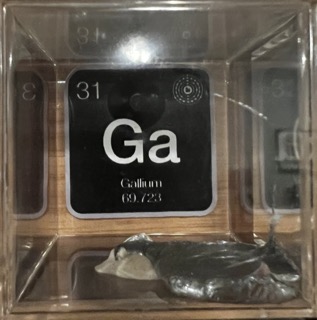Gallium
Atomic Number: 31
Atomic Mass: 69.723 u


Gallium, a fascinating element with unique properties and versatile applications, has captured the curiosity of scientists and technologists alike. From its discovery in the late 19th century to its crucial role in modern electronics and medicine, gallium’s journey through history is as intriguing as its behavior on the atomic level. For college students diving into the world of chemistry, materials science, or physics, understanding gallium offers insights into how elements can profoundly impact technological advancement and daily life. This blog post explores the discovery of gallium, its atomic characteristics, and its contemporary uses in society.
Discovery of Gallium
Gallium was discovered in 1875 by French chemist Paul-Émile Lecoq de Boisbaudran, not through direct isolation, but via spectral analysis. The element displayed two violet lines in its spectrum, which had never been observed, leading to the confirmation of its existence. What makes the discovery of gallium particularly noteworthy is its prediction by Dmitri Mendeleev. Before its discovery, Mendeleev had predicted the existence and properties of an element he called “eka-aluminum” based on gaps in his periodic table. Gallium’s properties closely matched Mendeleev’s predictions, showcasing the power of the periodic table in understanding elemental properties.
Atomic Makeup of Gallium
Gallium is element number 31 on the periodic table, nestled in the ‘p-block’ among the post-transition metals. With an atomic weight of 69.723, gallium has some peculiar properties that stem from its electronic configuration ([Ar] 3d^10 4s^2 4p^1). This configuration gives gallium a melting point of just about 29.76°C (85.57°F), meaning it can melt from a solid to a liquid in the palm of your hand. Despite this low melting point, gallium’s boiling point is quite high, at 2204°C (3999°F), showcasing its ability to remain in a liquid state across a broad range of temperatures.
Gallium has a few stable isotopes, with ^69Ga and ^71Ga being the most common in nature. This element does not exist by itself in nature but is extracted from bauxite or sphalerite during the processing of aluminum and zinc, respectively.
Uses of Gallium in Today’s Society
Semiconductors and Electronics
The most significant use of gallium today is in the creation of gallium arsenide (GaAs) and gallium nitride (GaN), compounds used extensively in semiconductors. GaAs is known for its superior electronic properties, including a higher electron mobility than silicon, making it ideal for high-frequency applications, such as microwave and millimeter-wave circuits, and in the manufacture of LEDs and laser diodes. GaN, on the other hand, is used in power electronics and RF amplifiers, offering high efficiency and the ability to operate at higher temperatures and voltages than silicon-based devices.
Solar Panels
Gallium is also a key component in the production of high-efficiency solar panels. Specifically, copper indium gallium selenide (CIGS) solar cells are noted for their high absorption efficiency and flexibility, making them suitable for a wide range of applications, from rooftop solar panels to portable solar chargers.
Medical Applications
In the medical field, gallium has found its place in diagnostics and treatment. Gallium isotopes are used in radiopharmaceuticals for nuclear medicine imaging, helping diagnose and treat various conditions, such as infections, tumors, and bone diseases.
Thermometers
Gallium’s unique melting point has led to its use in high-precision thermometers, especially in applications requiring stability over a wide temperature range. Gallium-based thermometers are non-toxic alternatives to mercury thermometers, offering safety and environmental benefits.
Research and Development
In scientific research, gallium’s liquid metal properties enable it to form alloys with a low melting point. These alloys are used in research and development for soft robotics, flexible electronics, and various applications requiring materials that change state or shape at relatively low temperatures.
Conclusion
From its serendipitous discovery to its foundational role in modern technology, gallium exemplifies how a single element can transcend its atomic characteristics to become a cornerstone of innovation. For college students and young scientists, gallium’s story is a testament to the endless possibilities that lie in the understanding and application of the elements. Whether in the advancement of electronics, the exploration of renewable energy, or the pursuit of medical breakthroughs, gallium continues to be a key player in shaping our technological landscape and improving our quality of life.
Hey, young scientists! Have you ever heard of a metal that can melt in your hand? No, it’s not magic—it’s gallium! Gallium is one of the coolest elements on the periodic table, and it’s got some pretty amazing tricks up its sleeve. Let’s dive into the world of gallium and discover some fun facts and how it’s used in all sorts of cool stuff today!
What is Gallium?
Gallium is a shiny, silvery metal that’s super special because it has a very low melting point. This means it can turn from a solid into a liquid super quickly—not by heating it up on a stove, but just by holding it in your hand! Its melting point is about 29.76°C (85.57°F), which is just a little warmer than a hot summer day.
Fun Facts About Gallium
- A Melting Marvel: Imagine a metal spoon that melts as you’re scooping up your ice cream—that could happen with gallium because it melts so easily!
- Discovered by Accident: Gallium was discovered by a French chemist named Paul-Émile Lecoq de Boisbaudran in 1875. He found it by accident while he was looking at a spectrum of light that came from a mineral sample.
- Not Found Alone: In nature, gallium doesn’t like to be alone; it’s always found hanging out with other metals in minerals.
- Super Cool Science Trick: Because it melts in your hand, gallium is awesome for science experiments. You can make your own gallium spoon and watch it melt in warm water!
- Named After France: The name “gallium” comes from “Gallia,” the Latin name for France, where it was discovered. But, fun fact: the scientist who discovered it played a little joke by naming it after himself too, because “Lecoq” is French for “the rooster,” and “gallus” is Latin for rooster!
Amazing Uses of Gallium Today
Electronics Wizard
Gallium is a superstar in making gadgets work. It’s used in semiconductors for electronics, which are parts that help control the electricity in devices. Thanks to gallium, we have super-fast computers and smartphones!
Solar Power Hero
Gallium is also used in solar panels to help capture sunlight and turn it into electricity. This helps power homes and gadgets using the power of the sun, making gallium a hero in the quest for clean energy.
Medical Detective
In medicine, gallium has a special role in helping doctors see inside the body. Some medical imaging tests use gallium because it can show up really well on scans, helping doctors find out what’s making someone sick.
LED Lights
Gallium helps make the bright and colorful lights in LEDs (Light Emitting Diodes). So, when you’re playing with your LED-lit toys or using a flashlight, gallium is working hard to light up your world.
Why Gallium is Super Cool
Gallium might not be as famous as gold or silver, but it’s definitely a superhero in the world of metals. Its ability to melt in your hand and its use in all sorts of modern technology make it a fascinating element to learn about. Gallium shows us that the elements on the periodic table are full of surprises and have amazing stories to tell.
So, the next time you’re holding your smartphone or turning on an LED light, remember that gallium is working behind the scenes, making our modern world brighter and more fun. Keep exploring, young scientists, and who knows what other incredible discoveries you’ll make in the amazing world of elements!
In the element box, a gallium spoon in honor of the disappearing spoon trick, however, during the summer our A/C was off and it melted when the house got above 86 degrees F.
No media at this time.
 using WordPress and
using WordPress and
No responses yet